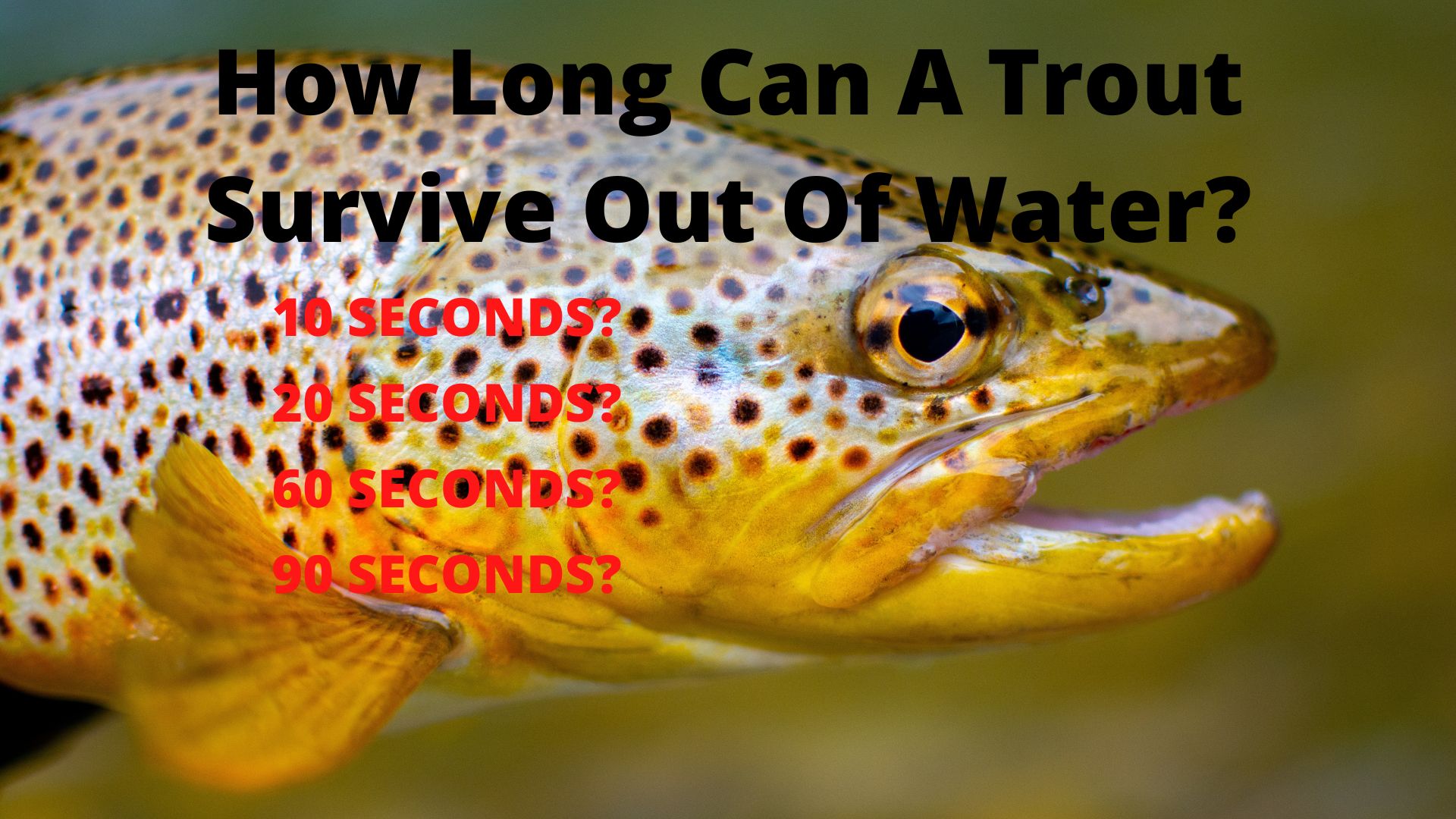This is going to be a short article on how long can trout survive out of water. The answer to this question depends on how exhausted or stressed the trout is.
One experiment looked at hatchery trout, caught under low-stress conditions, such as a short fight and cold water temperatures research has shown that 9% of trout died after air exposure of over 5 minutes. While less than 3% died if air exposure was under 3 minutes.
In another experiment, brook trout were exposed to the air for periods of up to two minutes.
Trout that were exposed to air for under 60 seconds swam away just fine.
Trout which were exposed to air for two minutes had a 75% reduction in swimming performance, with half of the trout refusing to move at all.
These trout did eventually recover, however, they were in the relative safety of a hatchery. In the wild, such heavily fatigued fish will be extremely vulnerable to predation.
Just because trout can survive out of the water for up to a minute without any noticeable difficulties. It does not mean trout should be kept out of the water longer than necessary. The fact remains, the longer a trout is out of the water its chance of survival decreases.
Factors that significantly reduce the amount of time trout can survive out of the water.
Long Fight times
The longer, and more intense the fight, the more vulnerable trout become to air exposure. If a fight goes on for more than a few minutes trout start to suffer from the effects of exhaustion.
This combined with air exposure significantly reduces the chance they will survive. After a long fight, it is of paramount importance to minimize the amount of time a trout is out of the water.
Think of it this way, how long can you hold your breath after sprinting 400 meters?
Warm water temperature
When water temperatures are high (over 68f), trout struggle to get enough oxygen from the water. Catching trout to release at such temperatures is often seen as unethical due to the stress the trout are already under
Because the trout are already in an exhausted state any caught are less capable of dealing with long periods of air exposure. When water temperatures are warm the odds are not in the trout’s favor. So keep them in the water as much as possible.
Below freezing air temperatures
Extremely cold air temperatures can cause freezing to occur on a trout’s gill. This significantly reduces the amount of time they can spend out of water.
So when releasing trout in below-freezing conditions, make sure to return the fish to the water as quickly as possible. Ice forming on the gills is more damaging than air exposure.
How long do anglers typically hold trout out of the water?
Researchers anonymously observed close to 300 trout fishermen in Idaho and recorded how long they kept trout out of the water.
They found on average trout were kept trout out of the water for 29.6 seconds. With the longest continuous time out of the water averaging 26.1 seconds. Yes, most fishermen had the trout out of the water for close to half a minute.
The longest total time out of the water was 165 seconds, which is over two and a half minutes.
The researchers also found that fly fishermen kept trout out of the water for a shorter amount of time than bait or lure fishermen.
Finally, large trout were typically kept out of the water longer (36s) than smaller trout (22.5s). The researchers put this down to smaller trout being easier to release. I personally suspect it could be because more photos are taken of big fish.
How to minimize air exposure when releasing trout
1) Use Barbless hooks, they are significantly faster to remove than barbed hooks.
2) Have hook-removing tools easily accessible. I always know where my forceps are.
3) Prepare your camera before taking the trout out of the water.
4) landing nets allow hook removal while the trout is still in the water. Although, many anglers held trout out of the water longer when they are in a net compared with being handheld.
5) Flies and lures are less likely to be swallowed than bait greatly speeding up hook removal time.
Sources:
Schreer, Jason F.; Resch, Dayna M.; Gately, Malachy L.; Cooke, Steven J. (2005). Swimming Performance of Brook Trout after Simulated Catch-and-Release Angling: Looking for Air Exposure Thresholds. North American Journal of Fisheries Management, 25(4), 1513–1517.doi:10.1577/M05-050.1
Lamansky, James A.; Meyer, Kevin A. (2016). Air Exposure Time of Trout Released by Anglers during Catch and Release. North American Journal of Fisheries Management, 36(5), 1018–1023. doi:10.1080/02755947.2016.1184200


Ice fishing here in Newfoundland, i can catch a trout, it freezes amoust instantly. I bring them home and put them in a sink full of cool water. Within a few minutes the trout comes back to life and swims around the sink. This has happened to me almost every winter. Amazing..
That is an amazing story. Thanks for sharing. I wonder in the extreme cold that the ‘surface’ moisture freezes so fast that it forms a protective layer around the fish. So the ice is acting as an insulating layer protecting the internal moisture from feezing. Because the trout is cold blooded their metabolism slows right down and they enter a state of suspended animation.
I know in vineyards and orchards for frost control, they sometimes spray water over new growth, and the mist freezes covering the shoot in ice which insulates it at 0c. This layer of 0c ice then protects the delicate new growth from the much colder air temperature preventing damage.